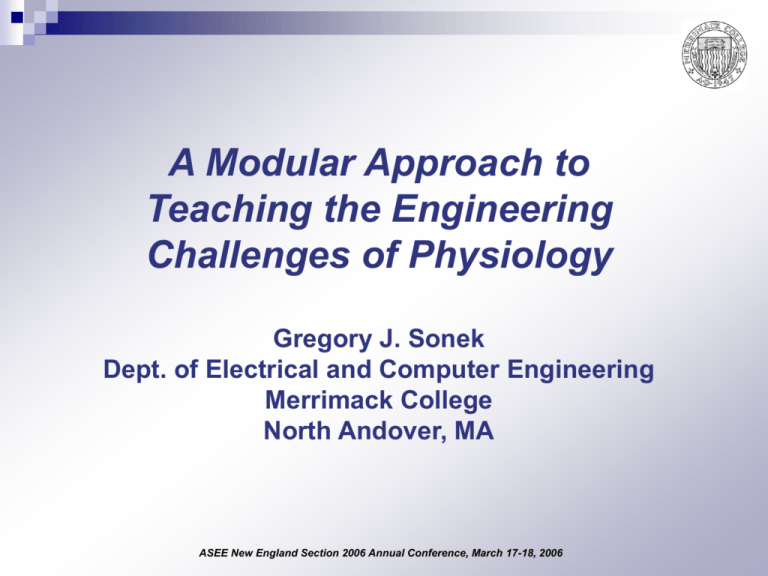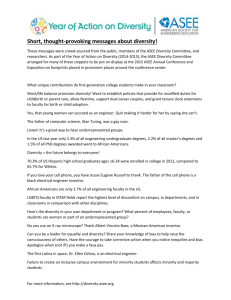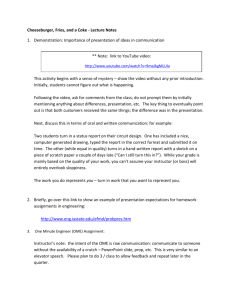View PowerPoint
advertisement

A Modular Approach to Teaching the Engineering Challenges of Physiology Gregory J. Sonek Dept. of Electrical and Computer Engineering Merrimack College North Andover, MA ASEE New England Section 2006 Annual Conference, March 17-18, 2006 • Background and Introduction • Course Structure and Development • Examples of Themes and Projects • Results and Conclusions ASEE New England Section 2006 Annual Conference, March 17-18, 2006 Background and Introduction “Engineering Challenges in Physiology” is a course offered as part of a biomedical engineering curriculum with the following goals and objectives: • • • To provide students with literacy and fluency in basic physiological processes and systems To enable students to identify, through an understanding of universal concepts and themes, engineering challenges i.e. needs and opportunities for new techniques, devices, and systems at the molecular, cellular, tissue, and whole body scales To provide an opportunity for application of course concepts through self study and exploration ASEE New England Section 2006 Annual Conference, March 17-18, 2006 Course Challenges Physiology is a highly interdisciplinary subject that crosses the boundaries of science and engineering. Both the audience and course content present significant challenges: • • • Course offered to undergraduates and graduates who are pursuing • BSBME degree, second major, and minor • ME, MS, and Ph.D. degrees • Certificate degree in bioengineering Draws students that have diverse educational backgrounds and varying degrees of industrial and professional training. Backgrounds include • Engineering (electrical, mechanical, chemical, biological) • Life sciences (biology, premedicine) • Physics Students are motivated to leverage existing or prior experiences with new coursework that will facilitate their involvement in the biomedical field ASEE New England Section 2006 Annual Conference, March 17-18, 2006 Course Challenges • • • The subject of physiology is vast and diverse Engineering concepts and themes must be reviewed and applied Engineering challenges must be identified ASEE New England Section 2006 Annual Conference, March 17-18, 2006 Course Structure and Development A modular approach was adopted to address course challenges: • • • • • • Present select topics in physiology in 2 – 3 week intensive modules for in depth study Develop common themes and concepts that bridge all systems Use a combination of lectures, text readings, homework, and weekly review of current events to engage all students Draw upon expertise from faculty and researchers in specific areas of physiology e.g. respiratory, neuro, cardiovascular, renal Focus on problem solving, identification of problems, and challenges Use a final project to integrate course concepts and provide an opportunity for research and self exploration ASEE New England Section 2006 Annual Conference, March 17-18, 2006 • Introduction to Engineering in Physiology Human body as a complex system; sensing, feedback, and control Physiological parameters, transport, fluid/gas mechanics, chemistry, electrical processes • • • • • • Cellular Physiology Cell structure, cell transport, ion channels Potentials (membrane, action), intracellular signaling, neurotransmission Neurophysiology Central and peripheral nervous systems, autonomic and sympathetic processes Receptors, neural pathways, sensory (auditory, visual) systems Interfacing with the nervous system, neuro-prosthetics, bionic devices Respiratory Physiology Functional anatomy and control of breathing Mechanics of breathing, gas exchange (diffusion), ventilation/perfusion matching Cardiovascular Physiology Basic hemodynamics, electrophysiology, electrocardiography Mechanical events of the cardiac cycle, peripheral circulation regulation Cardiac muscle mechanics, molecular cardiology Renal Physiology Quantitation of renal transport processes, renal tubular function Acid/base balance, blood pressure and volume control Special Topics Temperature regulation. exercise, high-altitude, and hyperbaric physiologies • Final Projects Student chosen projects in select areas of physiology ASEE New England Section 2006 Annual Conference, March 17-18, 2006 Basic Principles and Common Themes The course emphasizes many basic principles and themes common across all physiological systems, including: • • • • Energy Electrochemical potential, metabolism (ATP, glucose, FFA) Communications Signaling, receptors, integrated pathways Information Audition, vision, tactile sensing, neural processing Feedback & Control Open/closed loop, negative/positive feedback, sensor integration with chemical and neural systems • Transport Drift, diffusion, passive and active transport, fluids, gases, ions, solutes • Processes Chemical, mechanical, and electrical processes ASEE New England Section 2006 Annual Conference, March 17-18, 2006 Basic Principles and Common Themes An example of two principles that applies to many different systems are those of Ohm’s Law , where resistance represents opposition to flow (y = z x R) and Potential Energy (storage) represents the capacity for accumulation (y = 1/C z dt) Electrical Mechanical OHM’S LAW V = IR F = v Rm I CAPACITY q=CV x = F Cm F x F v Fluidic Thermal DP = Q Rf Dq = Q Rt Q DP = P1 – P2 q1 q2 DV = DP Cf Q = Dq Ct Q Chemical Df = Q Rc f1 f2 DV M = V Cc Df = f1 - f2 ASEE New England Section 2006 Annual Conference, March 17-18, 2006 DP q2 q1 Universal Concepts and Themes BASIC CONTROL SYSTEM WITH NEGATIVE FEEDBACK Input, r Controller Action, u + Plant (Controlled System) Controller Feedback Signal, z Disturbance, x Output, y Feedback Sensor CONTROL SYSTEM WITH NEGATIVE AND POSTIVE FEEDBACK + Presynaptic Impulse + Na+ Current Sodium Conductance Membrane Voltage + - Potassium Conductance Net Inward Current Membrane Capacitance K+ Current Delay ASEE New England Section 2006 Annual Conference, March 17-18, 2006 Cardiovascular Feedback and Control INTERVENTION Arterial Pressure Increase Baroreceptor firing rate Baroreceptor stretch Decrease Sympathetic Activity Parasympathetic Activity a1-adrenergic receptor activation Systemic vascular resistance b1-adrenergic receptor activation Muscarinic receptor activation Force of Contraction Heart Rate Stroke Volume Cardiac Output ASEE New England Section 2006 Annual Conference, March 17-18, 2006 Application of Engineering Principles EXAMPLE: OXYGEN CONSUMPTION STEP CHEMICAL & PHYSICAL PRINCIPLES Alveolar Ventilation Fluid mechanics of laminar and turbulent flows Pulmonary Gas Exchange Diffusion; Henry’s Law; Law of Mass Action Allosteric conformational effects on hemoglobin Oxygenated Blood Circulation Fluid mechanics; Physical chemistry of hemoglobin Extravascular Oxygen Distribution Diffusion Oxygen Transport into Cells & Mitochrondria Diffusion; Henry’s Law; Mass Action Cell Respiration Kinetics of electron transport chains ASEE New England Section 2006 Annual Conference, March 17-18, 2006 Analysis of Engineering and Clinical Data OBJECTIVE: To apply course engineering and physiological concepts to the solution of problems derived from real clinical or experimental data. EXAMPLE: To investigate the mechanics of breathing through the concepts of flow and pressure-flow relationships. Data is derived from spirometer and pneunotachograph measurements • IDENTIFY PATIENT P - V CURVES Emphysema Asthma dV’ Time (sec) Volume Pressure (cm H2O), Flow (L/sec), or Volume (L) • FIND RESISTANCE BY THE ISOVOLUME METHOD Near-Drowning dP Pressure Flow (V’) Volume (Integrated Flow) Pleural Pressure ASEE New England Section 2006 Annual Conference, March 17-18, 2006 Analysis of Physiological Data EXAMPLE: To explore the role that the kidneys and lungs play in acid/base balance and identification of various acid/base disorders, including metabolic and respiratory acidosis and alkalosis • • Henderson – Hasselbalch Eqn. Davenport Diagram pH = pK + log [HCO3-] 0.03 x PCO2 pH = Kidneys Lungs • Sample Conditions A = Uncompensated metabolic acidosis B = Metabolic alkalosis and respiratory acidosis Plasma [HCO3] (mEq/l) PCO2 60 35 PCO2 40 30 B PCO2 20 (mm Hg) 25 20 Buffer Line A 15 10 7.0 7.2 7.4 7.6 Plasma pH ASEE New England Section 2006 Annual Conference, March 17-18, 2006 7.8 Engineering Concepts and Challenges To further develop the theme of engineering challenges, modules use take home assignments that pose open ended questions or problems for which there are no current solutions. Some examples include: • • • Continuous Measurement of Airway Obstruction during Sleep Requires a method for analyzing nasal flow and chest/abdomen movement to diagnose hypopnea (reduction of airflow) in patients with obstructive sleep apnea (OSA) Implantable Gas Exchanger (Artificial Lung) as Lung Transplantation Alternative Considers the design of an artificial gas exchanger as an alternative to extracorporeal oxygen devices for patients with advanced lung disease Changes in Fluid Volumes and Osmolarities Considers the changes to intracellular and extracellular fluid volumes and osmolarities in marathon runners who compete on a hot day, rehydrate only with pure water, and suffer muscle cramping near the end of a race ASEE New England Section 2006 Annual Conference, March 17-18, 2006 Final Projects SUGGESTED TOPIC STUDENT PROJECTS Space Physiology “Physiological effects of fluid shifts on the cardiovascular system during space travel” Neonatal Physiology “Neurology and the human auditory system” “Effects of neutropenia in the neonate” “Respiratory physiology of preterm births” Sports Medicine Physiology “Turning Michael Johnson into a marathon runner” “Performance monitoring in cyclists: VO2 max, lactate threshold, nutrition, muscle function, and power training” High-Altitude Physiology “Engineering challenges in high-altitude physiology” Hyperbaric Medicine “Physiology under hyperbaric conditions” ASEE New England Section 2006 Annual Conference, March 17-18, 2006 Examples “Performance Monitoring in Cyclists: VO2 max, lactate threshold, nutrition, muscle function, and power training” OBJECTIVE: To understand VO2 max and the factors that affect it, from basic metabolic processes and barriers, to muscle types, nutrition, training regimens, and devices used to monitor performance Lactate Threshold Measurement Lactic Acid in Metabolism Do You Prefer White or Dark Meat? • Chickens also have slow and fast twitch fibers • Dark meat in the legs is mostly slow twitch • Good for walking and standing • Constant and low energy • White meat in wings and breasts are mostly fast twitch • Used in brief busts of flight • Lots of energy for short period of time ASEE New England Section 2006 Annual Conference, March 17-18, 2006 Examples “Physiology under Hyperbaric Conditions” OBJECTIVE: To understand the effects of pressure on the human body, including Dalton’s Law, tissue saturation, nitrogen narcosis, and the neurological effects of gas partial pressures (lipid bilayer alteration, modified neuronal firing rates) Pressure - Partial Pressure Other CO2 O2 Consequences of Gas Partial Pressure Alteration of Lipid Bilayer Governed by Dalton’s law: P = pN2+pO2+pCO2+…+pn Partial Pressures @ 1 ATA Partial Pressures @ 4 ATA N2 ASEE New England Section 2006 Annual Conference, March 17-18, 2006 Results and Conclusions • • • • A modular approach to the study of engineering and its challenges in physiology has proven to be a successful course model The course focuses on concepts and themes that are common to different physiological systems (cellular, neuro, respiratory, CV, renal) It has the goal of helping students identify engineering challenges (needs and opportunities) for new techniques, devices, and systems from the molecular to whole body scales The strength of the course lies in its breadth, interdisciplinary nature, and expertise brought by a diverse group of faculty and lecturers with backgrounds in engineering, medicine, R&D, and clinical applications ASEE New England Section 2006 Annual Conference, March 17-18, 2006 Acknowledgments We are grateful to all the participating faculty, researchers, and students at Tufts University who made this work possible: Prof. David Kaplan Dept. of Biomedical Engineering Prof. Andrew Hoffman School of Veterinary Medicine and Lung Function Testing Laboratory Prof. Larry Engelking Dept. of Biomedical Sciences and School of Veterinary Medicine Prof. Eunice Bloomquist Dept. of Physiology and School of Medicine Dr. Michael Mendelsohn Molecular Cardiology Institute and NEMC Dr. Ron Risso Inner Sea Tech BME Students Brian Orrick, Jason Waterman, Clemens Alt, Leonardo Angelone ASEE New England Section 2006 Annual Conference, March 17-18, 2006




